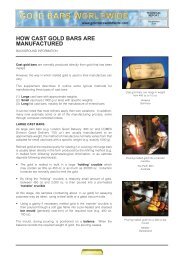Indian Gold Book:Indian Gold Book - Gold Bars Worldwide
Indian Gold Book:Indian Gold Book - Gold Bars Worldwide
Indian Gold Book:Indian Gold Book - Gold Bars Worldwide
You also want an ePaper? Increase the reach of your titles
YUMPU automatically turns print PDFs into web optimized ePapers that Google loves.
PRICING AND PROFITABILITY<br />
Bank importers normally mark-up imported TT bars by around 0.1%. Secondary and lower tier bullion<br />
dealers rely mainly on movements in the gold price for their profitability.<br />
<strong>Gold</strong> jewellery is typically retailed at a declared price ranging between 5 - 25% above the prevailing gold price.<br />
Retailers that sell gold jewellery with the correct caratage tend to have a gross profit (after fabrication costs) of less<br />
than 10%.<br />
Wholesalers generate a gross profit of 2 - 3%.<br />
Most goldsmiths earn between Rs 4,000 – 15,000 (US$ 80 - 300 per month).<br />
Small refiners can charge as little Rs 10 (US$ 0.20) per 10 g to refine small quantities of old gold jewellery.<br />
Coin fabricators charge between Rs 20 – 60 (US$ 0.40 – 1.20) to make a 10 g coin.<br />
Retailers usually sell a 10 g coin at a mark-up of less than Rs 50 (US$ 1.00).<br />
PERSPECTIVE<br />
This section can only provide indicative information. Pricing and profitability for each trade category can vary regionally,<br />
within cities, and in the rural areas.<br />
While there is some reference to the pricing of smaller businesses, the section focuses mainly on top end businesses for two<br />
reasons. Within cities (and nationally), top end jewellery retailers are important as retail conduits. Although their standard<br />
prices tend to be higher, the important point is that even these higher prices are extremely low by Western standards.<br />
Tax elements<br />
Reference to Customs duty, and State and municipal taxes, is usually omitted in this section for two reasons.<br />
Standard bullion prices can sometimes incorporate these taxes.<br />
State sales and other taxes, applicable to jewellery and other products, vary. For example, the State sales tax applied to<br />
gold jewellery in the 4 main cities ranges from 1% in New Delhi to 4% in Chennai. The level of taxes can also change.<br />
KEY FEATURES AT THE RETAIL LEVEL<br />
Prices are “unfixed” at every level.<br />
The prices of all gold products are generally unfixed, linked to the prevailing gold bullion price at the time of the<br />
transaction.<br />
Although some of the national retail jewellery chains, established since the mid-1990s, have started selling branded<br />
jewellery at fixed prices, their combined volume accounts for less than 1% of the market.<br />
Customers require a breakdown of charges.<br />
Customers, at every level, normally require a detailed breakdown of all charges. For example, jewellery retailers are<br />
expected to advise customers of the value of the carat gold content, the fabrication or “value addition” charge (including not<br />
only the “labour” or “making” charge to fabricate the item, but also in many cases the “wastage” factor), the value of the<br />
precious or semi-precious stones if the item is studded, and the relevant taxes.<br />
Customers ask what price they will receive if they sell back or exchange the item.<br />
Many retailers observe that this question is almost invariably asked at the time of purchase. For most customers, jewellery<br />
is viewed as a tradable asset.<br />
Customers bargain.<br />
Buying, exchanging or selling jewellery, bars and coins invariably involves some bargaining between the customer and the<br />
retailer, even though the discount tends to be small as the retailer’s gross margin above the prevailing gold price is<br />
generally so low.<br />
AN INTRODUCTION TO THE INDIAN GOLD MARKET 153

















